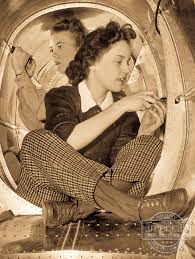 The wonderful people portrayed in Tom Brokaw’s The Greatest Generation (1998, Random House) were a tough act to follow. These were “America’s citizen heroes and heroines who came of age during the Great Depression and the Second World War and went on to build modern America.” A good case can be made that this remarkable group had its roots several decades earlier and laid the cultural foundation for very special future generations.
The wonderful people portrayed in Tom Brokaw’s The Greatest Generation (1998, Random House) were a tough act to follow. These were “America’s citizen heroes and heroines who came of age during the Great Depression and the Second World War and went on to build modern America.” A good case can be made that this remarkable group had its roots several decades earlier and laid the cultural foundation for very special future generations.
Brokaw’s touching individual portraits of ordinary and famous people who symbolized their generation highlight many common threads in their personalities and outlooks. As one reviewer noted, they shared a standard of sacrifice, responsibility, and “non-whining patriotism.” These strengths, thank heavens, were tailor made for fighting and winning WWII. As a country, we also benefited enormously from some of the greatest political and military leaders any nation ever knew.
At the top, of course, we had perhaps the ultimate inspirational leader, President Franklin Roosevelt, partnered with his eyes and ears on America, the tireless first lady Eleanor. Any potential doubts about their ability to call forth the absolute best our country had to offer are elegantly put to rest in Doris Kearns Goodwin’s Pulitzer Prize winning book, “No Ordinary Time” (1994, Simon & Schuster). Surrounding the Roosevelts was an extraordinary constellation of brilliant minds, including FDR’s alter ego, Harry Hopkins, General George Marshall, General Henry “Hap” Arnold, Admiral Ernest King, Admiral William Leahy and my personal favorite, Admiral Chester Nimitz.
Nimitz was the real deal, the complete heroic package. Raised around hotels in Fredericksburg, Texas, he was hand-picked by FDR to lead the Navy’s battle against Japan in the Pacific after Pearl Harbor. Nimitz (Annapolis class of 1905) was intensely yet modestly intelligent, coolly strategic and visionary to his core, dedicated to and compassionate toward his fighting force right down to ordinary sailors, fiercely devoted to his family, and movie star handsome to boot. One of my favorite Nimitz quotes includes “God grant me the courage not to give up what I think is right even though I think it is hopeless.”
Perhaps nothing better demonstrated Roosevelt’s charisma and natural ability to connect with everyday Americans than our country’s WWII production record. In just a few years, the United States went from a commercial and industrial powerhouse to an armament and munitions juggernaut. One of FDR’s first public goals for a country he dubbed the “arsenal of democracy” was the staggering figure of 60,000 warplanes per year. As he said in this 1/6/42 State of the Union address, “Let no man say it cannot be done.”
And done it was, with “Rosie the riveter” in lockstep. By the time Japan surrendered after being bombed into near oblivion, the United States had manufactured approximately 300,000 planes including 100,000 fighters, 107,000 tanks, 630 warships including 22 aircraft carriers, 349 destroyers, 48 cruisers and 203 submarines; plus, are you ready, 20 million rifles, pistols and machine guns and 44 billion rounds of ammunition (cf. Goodwin, p. 608).
While Detroit’s massive transition from automobile to weapons manufacturing is well known, including a staggering 455,000 aircraft engines, the contributions of lower profile industries to winning the war were remarkable. Goodwin describes a dazzling array of businesses that transformed themselves, including a merry-go-round maker that retooled itself into a gun mount factory. Elsewhere she noted, “Pride could also be taken in General Motors’ AC Spark Plug factory, which had turned from spark plugs to .50-caliber machine guns and was now rifling forty barrels in the time it used to take to rifle one…” (p. 259). And how about a corset manufacturer that began to make grenades. Or, incredibly, a pinball machine factory that converted to manufacturing armor piercing shells!
Our greatest generation got involved all over the field, not just on the production lines. Goodwin further reports that “Enthusiastic householders, delighted at the call for service, hauled an astonishing collection of aluminum wares to their village greens—Uncle Mike’s coffeepot, Aunt Margaret’s frying pan, the baby’s milk dish, skillets, stew pots, cocktail shakers, ice-cube forms, artificial legs, cigar tubes, watch cases, and radio parts” (p. 260). If you were big enough to retrieve a discarded can or tool or spool of wire, you were big enough to help America fight for its way of life.
Against this avalanche of productive activity, America could boast the genesis of what amounted to the country’s soundtrack—the silky harmony of the fabulous Glenn Miller orchestra. Sometimes overlooked in the wake of later pop music stars, Miller’s band recorded an astounding 70 top ten hits between 1939-1942, including songs that endure beautifully today such as “Moonlight Serenade” and “A String of Pearls.” Adding to his indelible luster, Miller devoted his last years to boosting troop morale, leading his orchestra as a captain in the Army Specialist Corps.
Some people believe, credibly, that the “Greatest Generation” was just that, and will never be equaled. Fundamentally I agree but it’s almost too easy a conclusion against which several examples come to mind. Starting with an easy one, if you close your eyes and play the right recording (1983’s “Live From San Francisco” works powerfully), the incredible big band leader Maynard Ferguson reminds me of Glenn Miller, or maybe Miller’s son on musical steroids so to speak. The basic instrumentation led by an impeccable trumpet section, the skin tight harmonies, the obvious appeal to wide audiences.
Other examples of how much recent generations are setting a high bar cover a wide cultural swath. We have the remarkable achievements of high tech companies and start-up wizards, not just in Silicon Valley but across the country. Casting an even broader net: according to the U.S. Patent Office, patents granted over the past 50 years have been steadily increasing (e.g., 48,971 in 1963 vs. 276,788 in 2012) which surely measures surging innovation and creativity on some level.
As for “softer” areas of achievement, charitable giving has increased recently. According to T. Rowe Price, “Charitable giving in America totaled $298.42 billion in 2011 — equal to about 2.0% of our nation’s gross domestic product. We have the highest percentage of giving of any nation in the world, as measured by percentage of the economy and by total dollars.”
And how about this. According to the Humane Society of the United States, “Americans have become much more aware of animal welfare issues in the past four decades . . . National shelter statistics show that the number of cats and dogs has steadily increased . . . From 1973 to 2007, the number of cats and dogs in U.S. households more than doubled and animal shelter euthanasia rates dropped by more than 60%.”
Maybe I’m trying to have it both ways. Most contemporary writers who discuss the men and women shaped by the catastrophic events of the 1930’s and 1940’s seem to agree that this generation was the heavyweight champion. Maybe their children’s and grandchildren’s generations are just excelling in different arenas, fighting different battles. As biased as I often am toward our older heroes, we still have a great deal to be very proud of. Maybe that’s what makes this country the best we—and the world– ever had.
–







